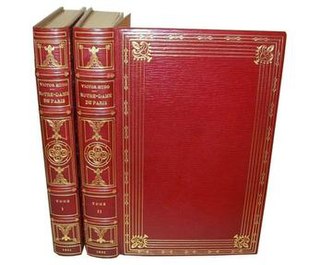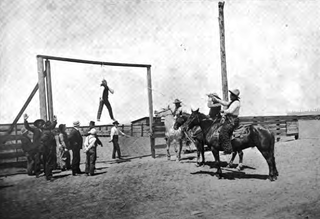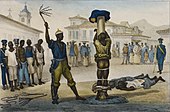History
Cropping is mentioned in ancient Assyrian law and the Babylonian Code of Hammurabi.
Cropping was quite rare in England, but more common in Guernsey. [7] Notable cases of cropping in England include Thomas Barrie in 1538, who reputedly died from shock following his cropping, [6] and John Bastwick, William Prynne, and Henry Burton in 1637. [8] In the 16th century, Henry VIII amended the laws on vagrancy to decree that first offences would be punished with three days in the stocks, second offences with cropping, and third offences with hanging. [9]
Records show that croppings took place in the United States in the late 18th century, particularly in states such as Pennsylvania [2] and Tennessee. [3]
From page 153 of Reverend Samuel Peters' General History of Connecticut, written during the colonial period, there is this account:
Newhaven is celebrated for giving the name of "Pumpkin Heads" to all of New Englanders. It originated from the "Blue Laws" which enjoined every male to have his hair cut round by a cap. When caps are not to be had, they substituted a hard shell of a pumpkin, which being put on the head every Saturday, the hair is cut by the shell all round the head…….. and fourthly, such persons as have lost their ears for heresy, and other wickedness, cannot conceal their misfortune and disgrace.
In Rhode Island, cropping was a punishment for crimes such as counterfeiting money, perjury, and "burning houses, barns, and outbuildings" (but not amounting to arson). [10] Cropping (along with the pillory and stocks) was abolished in Tennessee in 1829, with abolition further afield starting from approximately 1839. [11]
American Notes, a work written by Charles Dickens in 1842, describes the cropping of fleeing slaves' ears being used as identification after capture. [12]

Tennessee, officially the State of Tennessee, is a landlocked state in the Southeastern region of the United States. It borders Kentucky to the north, Virginia to the northeast, North Carolina to the east, Georgia, Alabama, and Mississippi to the south, Arkansas to the southwest, and Missouri to the northwest. Tennessee is the 36th-largest by area and the 15th-most populous of the 50 states. Tennessee is geographically, culturally, and legally divided into three Grand Divisions of East, Middle, and West Tennessee. Nashville is the state's capital and largest city, and anchors its largest metropolitan area. Other major cities include Memphis, Knoxville, Chattanooga, and Clarksville. Tennessee's population as of the 2020 United States census is approximately 6.9 million.

Victor-Marie Hugo, vicomte Hugo, sometimes nicknamed the Ocean Man, was a French Romantic writer and politician. During a literary career that spanned more than sixty years, he wrote in a variety of genres and forms.

The Hunchback of Notre-Dame is a French Gothic novel by Victor Hugo, published in 1831. The title refers to the Notre-Dame Cathedral, which features prominently throughout the novel. It focuses on the unfortunate story of Quasimodo, the Roma street dancer Esmeralda and Quasimodo's guardian the Archdeacon Claude Frollo in 15th-century Paris. All its elements—the Renaissance setting, impossible love affairs and marginalized characters—make the work a model of the literary themes of Romanticism.

Punishment, commonly, is the imposition of an undesirable or unpleasant outcome upon a group or individual, meted out by an authority—in contexts ranging from child discipline to criminal law—as a response and deterrent to a particular action or behavior that is deemed undesirable or unacceptable. It is, however, possible to distinguish between various different understandings of what punishment is.

Mutilation or maiming is severe damage to the body that has a subsequent utterly ruinous effect on an individual's quality of life.

The pillory is a device made of a wooden or metal framework erected on a post, with holes for securing the head and hands, used during the medieval and renaissance periods for punishment by public humiliation and often further physical abuse. The pillory is related to the stocks.

The Hunchback of Notre Dame is a 1996 American animated musical drama film produced by Walt Disney Feature Animation and released by Walt Disney Pictures. It is loosely based on the 1831 novel of the same name by Victor Hugo. The film was directed by Gary Trousdale and Kirk Wise and produced by Don Hahn, from a screenplay written by Tab Murphy, Irene Mecchi, Jonathan Roberts, and the writing team of Bob Tzudiker and Noni White. Featuring the voices of Tom Hulce, Demi Moore, Tony Jay, and Kevin Kline, the film follows Quasimodo, the deformed and confined bell-ringer of Notre Dame, and his yearning to explore the outside world and be accepted by society, against the wishes of his cruel, puritanical foster father Claude Frollo, who also wants to exterminate Paris' Roma population.

Quasimodo is a fictional character and the titular character of the novel The Hunchback of Notre-Dame (1831) by Victor Hugo. Quasimodo was born with a hunchback alongside several facial deformities and feared by the townspeople as a sort of monster, but he finds sanctuary in an unlikely love that is fulfilled only in death.

Alan Irwin Menken is an American composer, best known for his scores and songs for films produced by Walt Disney Animation Studios and Skydance Animation. Menken's music for The Little Mermaid (1989), Beauty and the Beast (1991), Aladdin (1992), and Pocahontas (1995) has each won him two Academy Awards. He also composed the scores and songs for Little Shop of Horrors (1986), Newsies (1992), The Hunchback of Notre Dame (1996), Hercules (1997), Home on the Range (2004), Enchanted (2007), Tangled (2010), and Disenchanted (2022), among others. His accolades include winning eight Academy Awards — becoming the second most prolific Oscar winner in the music categories after Alfred Newman, a Tony Award, eleven Grammy Awards, seven Golden Globe Awards, and a Daytime Emmy Award. Menken is one of nineteen people to have won an Emmy, a Grammy, an Oscar and a Tony.

Public humiliation or public shaming is a form of punishment whose main feature is dishonoring or disgracing a person, usually an offender or a prisoner, especially in a public place. It was regularly used as a form of judicially sanctioned punishment in previous centuries, and is still practiced by different means in the modern era.

Pierre Gringore was a popular French poet and playwright.
Amende honorable was originally a mode of punishment in France which required the offender, barefoot and stripped to his shirt, and led into a church or auditory with a torch in his hand and a rope round his neck held by the public executioner, to beg pardon on his knees of his God, his king, and his country.

Henry Burton (1578–1648), was an English puritan. Along with John Bastwick and William Prynne, Burton's ears were cut off in 1637 for writing pamphlets attacking the views of Archbishop Laud.

Horse theft is the crime of stealing horses. A person engaged in stealing horses is known as a horse thief. Historically, punishments were often severe for horse theft, with several cultures pronouncing the sentence of death upon actual or presumed thieves. Several societies were formed in the United States to prevent horse theft and apprehend horse thieves. However, horse theft continues to occur throughout the world, as horses are stolen for their meat, for ransom, or in disputes between their owners and other persons. Horse theft today is comparable to automobile theft, a crime punishable by felony jail time.

Teresa Elizabeth Furtado was an actress at London's Adelphi Theatre where she played leading melodramatic roles for nine seasons.
Thomas Barrie was an English almoner who was found guilty of spreading rumours about the death of Henry VIII in 1538 and was pilloried in the market square at Newbury. It was reported that he died from shock as a result of his punishment.

La Esmeralda is a grand opera in four acts composed by Louise Bertin. The libretto was written by Victor Hugo, who had adapted it from his 1831 novel Notre-Dame de Paris. The opera premiered at the Théâtre de l'Académie Royale de Musique in Paris on 14 November 1836 with Cornélie Falcon in the title role. Despite the lavish production, the premiere was a failure, and La Esmeralda proved to be the last opera composed by Bertin, although she lived for another 40 years.
"God Help the Outcasts" is a song written by composer Alan Menken and lyricist Stephen Schwartz for Walt Disney Pictures' animated film The Hunchback of Notre Dame (1996). A pop ballad, the song is performed by American singer Heidi Mollenhauer as the singing voice of Esmeralda on American actress Demi Moore's behalf, who provides the character's speaking voice. A prayer, "God Help the Outcasts" is a somber hymn in which a beset Esmeralda asks God to shield outcasts and Roma like herself against racism and discrimination at the hands of Paris and Judge Claude Frollo. The song also establishes Esmeralda as a selfless, empathetic character with whom Quasimodo falls in love.
In September 2003, Barnes & Noble Books of New York began to publish The Collector's Library series of some of the world's most notable literary works. By October 2005, fifty-nine volumes had been printed. Each unabridged volume is book size octodecimo, or 4 x 6-1/2 inches, printed in hardback, on high-quality paper, bound in real cloth, and contains a dust jacket. In 2015, The Collector's Library was acquired by Pan Macmillan.















